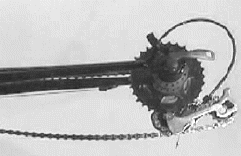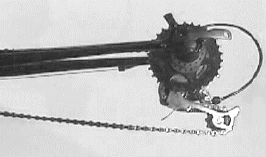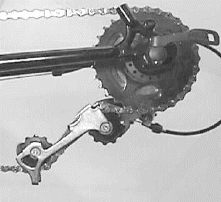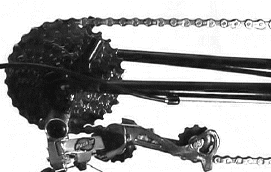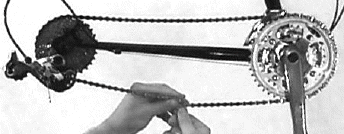

Setting derailleur chain length
Level of Difficulty: Novice
Typical tools and supplies [1]
- Chain Tool
- Repair Stand to hold bike (optional but nice)
- Special Replacement pin for Shimano® or special link for Campagnolo® chains as appropriate
- Tape measure (optional, for 'Formula Method' only)
- Chain Lubricant
- Rags
This article will discuss sizing derailleur chain to length. See also related articles:
Chains for derailleur bicycle should be an adequate length. A chain that is too long or too short can cause shifting and riding problems. However, the rear derailleur cage should be long enough to take up slack as the chain is moved between the different gear combinations. This is referred to as "total capacity", and is discussed below.
This article will describe three methods to achieve adequate chain length. All three methods tend to yield adequate chain lengths. It is not necessary to use all three methods, as one method may appeal to you and your situation. The first system described is the 'existing chain' method. It assumes the bike already has a chain in place. The second system is 'largest cog-to-largest chainring' method, and does not require the pre-existing chain. The last system is the 'formula method', and uses simple math to determine chain length.
Rear Suspension: If the bike has a rear suspension linkage, it is usually necessary to account for the movement of the rear hub from the bottom bracket. If the rear hub moves away from the bottom bracket, set chain length is the longest position. Consult the bike manufacturer for correct chain length if in doubt.
Derailleur Capacity: The derailleur capacity refers to the derailleur's ability to take up chain slack as the derailleur shifts between different gear combinations. Some bicycles may have sprocket combinations that do not allow the derailleur to take up the chain slack. In this case, the gearing on the bike exceeds the capacity of the derailleur. If the derailleur capacity does not match the gear sizes on the bike, the chain may appear to fail either the 'too long' test or the 'too short' test. A chain length cannot be found that will pass both tests. In this case it is better to size a chain for too long rather than too short. Both the 'existing chain' and 'formula' methods below will safely size a chain when a bike is violating the derailleur capacity. It may be necessary to avoid gear combinations that cause problems in pedaling or shifting on these bikes.
Chain sizing: Existing chain method
Before removing the old chain, check the bike for acceptable length. Cut the new chain relative to the old chain length.
Shift bike to smallest chainring in front and smallest cog in back. Inspect the section of chain between lower derailleur pulley wheel and bottom of smallest chainring. There should not be an obvious sag in the chain. Check also that the lower section of chain does not rub chain at upper pulley. It is normal for there be low chain tension in this position, but the chain should not sag. Sagging in this position indicates a chain that is too long.
|
Too long a chain length sags in smallest cog front and rear. Note chain-to-chain contact at upper pulley. |
Adequate chain length will not sag. |
If the chain is too long, find the chain rivet contacting bottom of chainring, and mark the chainring at this point. Count two chain rivets toward derailleur, lift this rivet and move to position of mark. Chain is now effectively shorter. Check for sag again. Repeat counting two rivets and moving to chainring mark. Number of rivets to shorten must be an even number (2, 4, 6, etc.) Repeat until chain has no visible sag.
|
To determine if the chain is too short, shift chain to largest chainring and second largest rear cog. Chain will appear tighter in this position. Inspect chain for "S" bend as it passes through pulley wheels. Shift slowly and carefully to largest rear cog. If chain appears to jam, it is too short. If chain does shift, but there appears to be no double bend of the chain at the pulley wheels, it is too short. You will need to add two rivet lengths to new chain compared to the old chain. Note: Do not attempt to lengthen an old chain by adding new links. |
||||
|
|||||
If the current chain length passes one of the tests above, but fails the other, it is likely the derailleur capacity does not match the gearing on the bike. Set the chain length so it passes the large ring to largest rear spocket test. It will then be the responsibility of the user to avoid shifting to gear combinations that cause chain slack.
If a new chain is being installed and the old chain is the correct length, the new one may be shortened to the old length before being installed. First, remove the old chain and lay it on a flat surface with the rollers aligned vertically. Pull the chain straight. Lay the new chain next to the old chain in the same fashion. Make sure the ends of the two chains match, with either a rivet or no rivet at each end. The new chain will appear shorter, so push the links of the old chain back to match up with the new chain. Locate the matching end rivet on the new chain with the rivet on the old chain. Add or subtract chain links as necessary from inspection results stated above and cut the chain at this point.
Chain sizing: Largest cog and largest chainring method
An alternative method for determining chain length for new chains is to use the largest size sprockets on the bike. It is easiest to size the chain without threading it through the derailler.
- Remove the old chain.
- Shift the front derailleur over the largest chainring, and the rear derailleur on the smallest cog.
- Thread the new chain through the front derailleur. It is not necessary to thread the chain through the rear derailleur at this point. Simply wrap the chain around the largest front chainring and around the largest rear cog.
- Pull the chain tight, and note the closest rivet where the two could be joined. Keep in mind a chain can only be joined by mating inner and outer plates.
- From the closet rivet, lengthen the chain by counting over an additional two rivets (two links), which is a distance of one-inch. Cut the chain at this point.
- Remove the chain from the bike and thread it through both derailleurs and join the ends.
Note on master links: If the bike chain uses a "master link", it is necessary to account for the link. Install one-half of the master link on one side of the chain. Size the chain by cutting the other end of the chain.
|
|
|
Chain sizing: Formula method
Bicycle chains consist of inner and outer plates, and can only be connected at even inch increments. For example, new chains can be 52 inches, 53 inches, etc. However, chains cannot be cut to 52-1/4in, 53-1/8in, or even 52-1/2in. It is possible to determine chain length from standard drive train equations for chains, and then cut the chain before installing it on the bike.
Begin by counting the number of teeth on the largest front sprocket and largest rear. These numbers are often printed right on the sprockets and cogs. Next, measure the distance between the middle of the crankarm bolt to the rear axle. This is also the chain stay length. Measure to the closest 1/8in, and convert this to decimal form. A simple chart below will assist this conversion.
Fractional conversion chart for 1/8in measurements
1/8in = 0.125in
1/4in = 0.25in
3/8in = 0.375in
1/2in = 0.5in
5/8in = 0.625in
3/4in = 0.75in
7/8in = 0.875in
There are two different chain length equations below. Described first is a short, simplified formula, which applies to most MTB and hybrid type bikes. Road racing bikes, which tend to use shorter chain stays and have a relatively large difference between largest front and back sprockets, should use the longer formula. The simplified formula below is applicable for the following sprocket combinations.
Short formula
Use short formula if:
42t or 44t largest front ring with largest rear 22t or bigger.
46t or 48t largest front ring with 28t or bigger.
52t or 53t largest front ring with largest rear 30t or bigger.
The short formula is:
L = 2*C + F/4 + R/4 + 1
L = Chain length in inches. Round the final result to closest whole inch figure.
Remember to round up from 0.5.
C = Chain stay length in inches, measure to closest 1/8in. Use chart below to
find decimal measurement.
F = Number of teeth on largest front chainring.
R = Number of teeth on largest rear cog.
* = multiply
Example: A bike has a 42-32-22 front chainring set up. Use only the 42 for the formula. The rear cog set has a 12-32 tooth largest cog. The bike measures 16-3/8in from the center of the rear axle to the center of the crankarm bolt. The decimal equivalent for 16-3/8in is 16.375 inches.
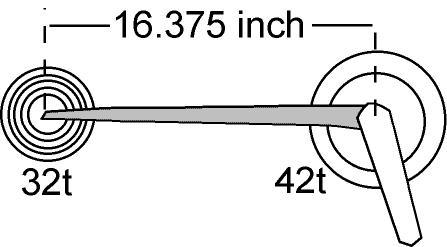
L = 2*16.375 + 42/4 + 32/4 + 1
In the example above, this becomes 32.75 + 10.5 + 8 + 1 = 52.25 inches
Chains cannot be joined at 52.25 inches, so this length is rounded to 52 inches.
Long formula
The more complete formula below is needed when the bike has shorter chain stays and there is a greater size difference between the largest front sprocket and the largest rear cog. This is seen typically on road racing bikes. Below is a table of largest sprocket combinations that should use the long formula.
42t or 44t largest front ring with largest rear 20t or less
46t or 48t largest front ring with largest rear 26t or less
53t or 52t largest front ring with largest rear 28t or less (most road performance
bikes)
The long formula is:
L = 2*C + F/4 + R/4 + [(F-R)2*0.01275*(1/C)] + 1
L = chain length in inches. Round the final result to closest whole inch figure.
Remember to round up from 0.5.
C = Chain stay length in inches, measure to closest 1/8in.
F= Number of teeth on largest front chainring.
R= Number of teeth on largest rear cog.
(Note: The truly accurate formula includes "2 x pi" as part of the denominator
under (F-R) squared. An approximation of 0.01275 is substituted in the interest
of simplification.)
For example, a bike has a 53 front ring and a 24 largest rear cog. The distance between the crankarm bolt and the rear axle is 15-7/8in, which using the chart below converts to 15.875in.
L = 2*15.875 + 53/4 + 24/4 + [(53-24)2*0.01275*1/15.875] + 1
or
L = 31.65 + 13.25 + 6 + [841*0.01275*0.063] + 1
L = 52.68
The final answer, 52.68 inches is rounded to simply 53 inches. Note that if the simplified formula were used, the length would have been 52 inches, one inch too short. Check the largest front and largest rear cog before determining which formula to use.
To measure the new chain, lay it on a flat surface with the rollers and plates aligned vertically. Pull on each end to straighten out the chain. Measure from either end. Remember, you can only shorten the chain at whole inch increments. If the chain uses a master link, install one half of the link in the chain for purposes of measuring, and measure including the link.
Suggested Park Tools
- Chain Tools: CT-2, CT-3, CT-5 or tool in MTB-1
- Repair Stand such as PCS-1 or PCS-4


